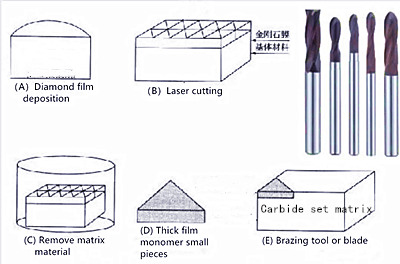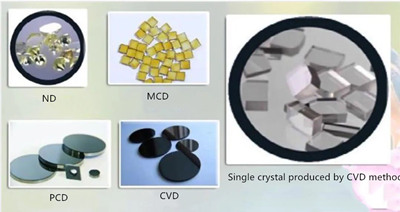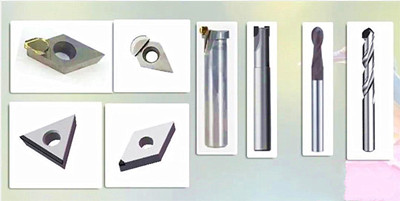
Different materials
1. ND is a natural diamond.
About 98% of natural diamonds belong to Type Ia nitrogen [N] (~2500ppm).
Most of the formation of natural diamonds is produced in rocks that are at least 2.5 billion years old, and are approximately 140 to 200 kilometers underground. Formation, the strong pressure (1.5 million pounds per square basal leaf) and extremely high temperature (approximately 2800°C) at this depth cause the rare carbon atoms to gather closely together to form a crystal structure.
2. MCD is an artificial single crystal made by the high temperature and high pressure method.
The artificial single crystal diamond is one of the type Ib single crystal synthetic diamonds. Nitrogen [N] mostly exists in the crystal in a dispersed or solid solution state. The artificial single crystal diamond is artificial Synthetic, synthesized in an oxygen-free, high temperature (above 1000°C) and high pressure (500 MPa) environment, due to its high hardness, high wear resistance and high thermal conductivity equivalent to diamond. The single crystal tool synthesized by the high temperature and high pressure method is generally yellow.
3. CVD is a single crystal made by chemical vapor deposition.
It is one of the type IIa diamond type single crystal synthetic diamonds. Nitrogen [N] <1 ppm, [B] <0.05 ppm. The process environment for CVD synthetic single crystal diamond is in the cavity of the mixture gas in the hydrogen to carbon, by chemical vapor deposition (CVD) method to synthesized, the CVD single crystal is generally colorless transparent crystals. This is a high-quality single crystal diamond synthesized by ultra-high technology, which can be completely colorless and transparent, almost free of any impurities, has higher wear resistance and better thermal conductivity, and can make the processed objects have more A higher-quality processing surface, and if the doping gas is selectively introduced during the growth process, a variety of colored diamonds can be prepared.
4. PCD is polycrystalline diamond.
PCD uses natural or synthetic diamond powder and bonding agent (containing cobalt, nickel and other metals) in a certain proportion at high temperature (1000~2000℃) and high pressure (50,000~100,000 atmospheres) It is sintered to form a PCD composite sheet with a fixed diameter and thickness, and then undergoes cutting, welding, sharpening and other processes to make a PCD tool. Under normal circumstances, the layer thickness of the PCD composite sheet is about 0.3 to 1.0 mm. It can be made into PCD inserts, PCD turning tools, PCD milling cutters, PCD reamers, PCD drill bits and other structural forms.

The CVD diamond thick film tool uses the plasma time-flow CVD method to deposit a diamond film on the Mo substrate to obtain an independent diamond thick film (0.3-1.3mm), and then through the welding process, the CVD diamond thick film is welded to the hard alloy or on the substrate of other materials, a CVD diamond thick film tool or blade is formed. The specific forming process of CVD is shown in the figure:


Different appearance
Natural single crystal tools are generally transparent, artificial single crystals are generally yellow or colored (CVD method), and PCD tools are generally black.

Performance difference
PCD tools are most suitable for processing aluminum and other tough non-ferrous alloys (such as copper, brass, and bronze), as well as highly abrasive composite materials (such as graphite, carbon-carbon materials, carbon-added phenolic, glass fiber, and porous seals) Material).
Single crystal diamond is almost exclusively used for high-precision finishing, and its extremely thin cutting ability can ensure extremely high dimensional accuracy. PCD and CVD diamond can be used in many of the same processing fields, but PCD is more suitable for rough machining and processing occasions that require high tool fracture toughness. CVD diamond is better at finishing, semi-finishing and continuous turning processing. This is because it has excellent wear resistance and high hardness, and can process more precise workpieces. At present, single crystal diamond tools and PCD are the most widely used, and CVD thick film tools are currently limited by the grinding process. "
---Data source Henan Superhard Materials Research Institute, 2015.
------EDITOR: Cindy Chen
---POST: Doris Hu
<< :The basic performance of cutting tools
<< :How to solve the problem of tool tip broken and singeing when machining parts?
PCD tools offer excellent hardness and wear resistance for machining difficult materials, but grinding them poses unique challenges. This article explores common issues such as chipping, high surface roughness, dimensional deviations, burning, and grinding wheel wear. Learn practical solutions to optimize grinding parameters, wheel selection, and machine accuracy to improve tool life and reduce costs.
Discover how our 3A1 ceramic diamond wheel helped a client achieve ultra-precise PCD reamer grinding. Learn how adjusting bond hardness and grit size resolved issues with carbide shank grinding for better edge quality and stability.
Add: Zhongyuan Rd, Zhongyuan District, Zhengzhou, 450001, Henan, China
Tel: +86 17700605088